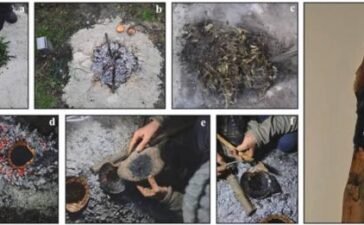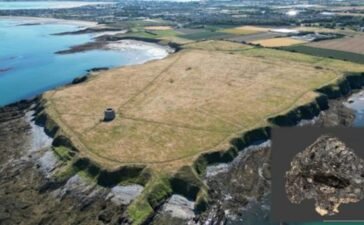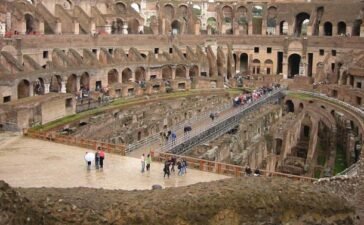A remarkable discovery has emerged from the heart of Central Europe, where Czech archaeologists have uncovered an exceptionally well-preserved Neolithic settlement near the town of Kutná Hora. This site, believed to be around 7,000 years old, offers a rare and invaluable glimpse into the lives of some of the first agricultural communities in the region. The settlement, named Dobřeň after a nearby village, has astonished researchers with the preservation of four longhouse floor plans, among other findings.
A Surprising Discovery in the Heart of Bohemia
According to an interview with Daniel Pilar from the Czech Academy of Sciences’ Department of Prehistorical Archaeology, by Radio Prague International, the site was discovered earlier this year during routine rescue excavations, a common practice in areas undergoing construction to ensure that any historical artifacts or structures are preserved. Daniel Pilař, part of the team that stumbled upon the site stated:
“This site was discovered early this spring as part of rescue excavations. We usually supervise construction work in our district and one day, in the middle of construction, we were surprised to find relics of a settlement that is not typical for this region. When we saw the house plans, we immediately knew we were dealing with a Neolithic settlement.”
The site’s preservation is extraordinary, a rarity in the region, as many Neolithic sites have been overlaid by subsequent settlements or destroyed by later agricultural practices. This unique circumstance has provided archaeologists with an unprecedented opportunity to study a Neolithic community in situ.

Neolithic post holes discovered at the site give an idea of the huge hall that once stood in this ancient spot. (Archeologický ústav AV ČR)
Uncovering the Remains of Neolithic Life
The discovery at Dobřeň is notable not just for its age, but for the intact nature of the settlement’s remains, explains the Institute of Archaeology of CAS press release. According to Pilař, the settlement was likely occupied for only a few generations before being abandoned. As a result, the site has remained largely undisturbed for millennia.
“The site is unique due to its state of preservation. It’s a miracle that this site was not overlaid or destroyed in later millennia,” Pilař noted. “With Dobřeň, it’s different. We think it was only used for a short period of time, maybe by a few generations. And in the next millennia, this place was never used, at least for living. So it offers us great insight into the Neolithic world.”
Among the most significant findings are the ground plans of four large houses, which are surprisingly well-defined given their age. These structures, built of wood, have long since decomposed, but the stone foundations and postholes remain.
“These houses consist of five lines made of stones. They were about five meters [16.4 feet] wide and 10 to 20 meters [32.8 to 65.6 feet] long, so they were quite big for the time,” Pilař explained.
“Besides the houses, we have found lots of pits there, which are very specific for prehistoric settlements because these pits were used for the extraction of clay that was used for the construction of houses.”
These pits, initially used to mine clay, were later repurposed as waste dumps, which have proven to be a treasure trove of information. The refuse found within them provides a detailed picture of the everyday lives of the settlement’s inhabitants.

Post hole sites marked out. (Archeologický ústav AV ČR)
Artifacts of the Neolithic Age
The artifacts uncovered at Dobřeň reveal a great deal about the daily activities and technological capabilities of these early European settlers. The team has uncovered pottery, flint blades, polished stone tools, and other implements that were essential to Neolithic life.
“They used, for example, pottery for cooking and for storage. They used flint blades for hunting or harvesting grains. They used polished stone tools, such as stone axes, for carpentry or stone mills for milling the grains,” Pilař described.
But these artifacts are only the beginning. Modern scientific analyses will allow researchers to delve deeper into the site’s secrets, including precise dating of the settlement and insights into the tools’ usage. Such analyses will also help reconstruct the environmental conditions of the region 7,000 years ago.

Milling stone found at the site. (Archeologický ústav AV ČR)
Why This Location?
While the settlement offers a wealth of information, questions remain about why these early agriculturalists chose this particular location. The site’s positioning between two streams would have provided fresh water, making it a seemingly ideal spot for a settlement. However, Pilař believes that the soil in the area may not have been as fertile as the settlers initially hoped.
“This place looks like an ideal spot for a Neolithic settlement because it lies on a slight slope between two streams, so there is fresh water nearby,” he explained. “The people who settled there probably didn’t know that the soil wasn’t fertile enough. They probably lived there for several generations but in the end, they left.”
This early exodus left the area largely untouched until the High Medieval Era, when it was once again settled by people with more advanced agricultural technology. Today, the site near Kutná Hora stands as a testament to the ingenuity and adaptability of early human societies, offering a rare glimpse into the dawn of European civilization.
Top image: Investigation of ancient remains at the Kutná Hora site, Czech Republic. Source: Archeologický ústav AV ČR






